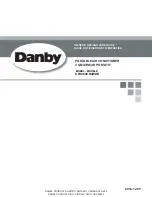
IM 934-2 Applied PDAA/PDHA / Page 17 of 44
Figure 25. Flush Stamped Louver
Figure 26. Architectural Louver
Louvers by others are acceptable as long as
they meet factory specifications. They must have a
minimum free area of 70% or a pressure drop not
exceeding .05 in. w.g. at 300 fpm face velocity and
a blade design that will not cause recirculation of
condenser air.
Note: A Flush Stamped Louver cannot be used with
a recessed louver wall sleeve. Recessed
Louver is special order. Contact factory for
more information if necessary.
Free area is defined by ASHRAE as the minimum
area of the openings in an air inlet or outlet through
which air can pass. Have your local McQuay
representative evaluate the application of special
louvers or building facade treatments that may
affect normal operation of the unit or restrict free
air discharge of condenser airflow. A louver design
that restricts the passage of condenser air or causes
condenser air to be recirculated can dramatically
alter the performance of the unit. Unit capacity and
efficiency may be decreased and fan motor and
compressor life can be shortened.
If the louver does not meet the requirements set
out above or it is only marginally acceptable, then
a drawing will be required for factory evaluation. If
acceptance cannot be determined by the drawing, then
a sample of the proposed louver must be sent to the
factory for testing and certification. The sample sent
for testing must be at least 16" high by 42" wide.
Figure 24. Thick wall installation with hydronic subbase
See Table 2,
page 16
1" (25mm)
Hydronic
Subbase
Floor
Hydronic
Heating
Coil
8
1
/
4
"
(209mm)
13
3
/
4
"
(349mm)
16"
(406mm)
Wall Sleeve
Room
Cabinet
17"
(432mm)
8
1
/
4
"
(209mm)
Wall
Sleeve
Extension
Outside
Louver
Mounting
Screws
(by installer)
Caulk
Perimeter
Steel Lintel
(by others)
Attaching Wall Sleeve to Subbase
1. Where a subbase is used, secure wall sleeve to
subbase with clips provided.
2. Caulk the wall sleeve to the wall opening on both
the inside and outside perimeter. Be careful not
to plug the weep holes. Caulking should be
resilient, nonhardening type such as silicone.
3. Secure the two sections by installing the clip
screws supplied with the hardware bag.
4. Caulk indoor/outdoor perimeter of wall sleeve
with resilient caulk such as silicone.
5. Finish any uncompleted electrical and/or plumbing
connections.
Outdoor Louvers
Two styles of exterior louvers are available. The
flush stamped louver is a one-piece stamped aluminum
type that is finished natural and clear anodized (Figure
25). Attractive, rugged architectural louvers (Figure
26) are extruded aluminum and are finished natural
and clear anodized (optional colors are also available).
Installation of Basic Wall Sleeve
















































